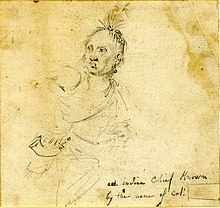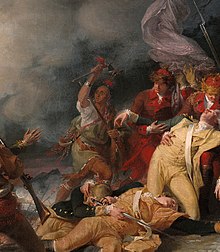Louis Cook
Louis Cook, or Akiatonharónkwen (died October 1814) (Mohawk), was an Iroquois leader and commissioned officer in the Continental Army during the American Revolution.
He represented them and the Seven Nations of Canada to negotiate with the government of New York state in trying to achieve more justice in postwar land deals.
Cook was born as Nia-man-rigounant to an Abenaki mother and Black father; while living in what is today Schuylerville, New York, the family was taken captive in a French-Mohawk raid in 1745.
[6] As he never fully accepted the British victory and found his homeland increasingly overrun by American colonists, he moved with his family to Akwesasne, a Mohawk village along the St. Lawrence River in what was then Quebec.
Although the Mohawk and three other of the Iroquois nations sided with the British during the American Revolution, hoping to expel the colonists from their lands, Cook allied with the Thirteen Colonies, as did the Oneida and Tuscarora.
[8] Cook returned in January 1776 with a group to meet with Philip Schuyler in Albany and with Washington and John Adams at Cambridge, Massachusetts.
A story that illustrates Cook’s fierceness as a fighter was that“ Lous Atayutaghranghta noticed that an enemy Indian was a crack shot.
Colonel Cook was a man of action who could be relied upon especially by the likes of our founding Fathers such as George Washington and John Adams.
Following the Battle of Klock's Field, Cook forded a river in pursuit of Sir John Johnson while General Rensselaer delayed.
In spring 1778, Peter Stephen DuPonceau wrote of meeting Cook, dressed in American regimentals, after hearing the officer singing a French aria.
[16] In March of that year, General Philip Schuyler sent Cook to destroy British ships at Niagara in order to prevent another Canadian expedition.
[20][21] Colonel Louis led a Native American delegation to greet General Rochambeau in 1780, where some officers noted he spoke French with no discernible accent.
The Oneida named Cook and Peter Otsequette to negotiate with Governor George Clinton for a return of, or compensation for, their land.
[25] The negotiations were related to lands sold by the people of two villages, Grand River and Tyendinaga Mohawk Territory, Ontario, who were led by Joseph Brant.
[26] The United States forgot Cook's earlier service and detained the Mohawk at Fort Niagara; he was released after producing proof of his commission in the Continental Army, as well as letters from George Washington.
Louis Cook fought for the United States and was even a good friend to the President but he still couldn’t attain the fair treatment that the rest of the Continental Army seemed to enjoy.

